Think about the time.
Is your wedding in the evening? Then a sit-down dinner might be the appropriate venue for your reception. A sit-down dinner is the most formal of all choices and usually follows a traditional wedding ceremony.
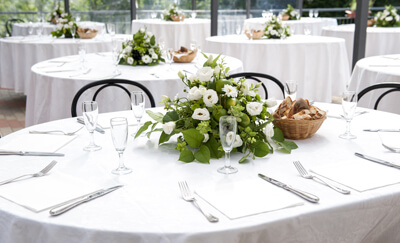
Having a sit down dinner in a well arranged hall can certainly create an elegant atmosphere.
Typically, food consist of hors d’oeuvres, an appetizer, and the main course followed by wedding cake and coffee. Main courses usually include a choice of meats and one or two starches plus a selection of either salad or a cooked vegetable.
Guests are served by waitstaff at table for a particularly elegant atmosphere. Given the personal attention to guests, plating and food preparation, a sit-down dinner is one of the more expensive options for reception refreshments.
Another choice for an evening wedding that is budget friendly is a cocktail party. This is less formal, of course, and allows for more mingling.
Food served at this type of event consists of an assortment of canapes, fruit and cheese trays, and sweet and savory appetizers along with a signature cocktail or a full bar. If you choose this format, you can eliminate the need to agonize over seating arrangements, as guests are encouraged to mingle freely.
A daytime wedding is the perfect for a buffet-style presentation. If your guest list is long (over 100 people) you might want to break up the buffet into several food stations scattered throughout the reception area to eliminate long food lines. Some options are a carving station, a pasta bar, a salad bar and made-to-order omelet station. In fact, you can have a lovely brunch reception with just an omelet bar, an assortment of fruit and muffin trays and a choice of juices and sparkling waters.
Another appropriate afternoon choice is to serve a traditional English tea. Guests can choose from an assortment of scones, pastries and tea sandwiches along with high quality teas, clotted cream and coffees.
Finally, a simple, casual barbecue can be a wonderful match for a small, friends-only wedding.
Emphasize your theme with food.
There is no better way create a festive atmosphere than with food! Are you having a island or beach-themed wedding? Think about throwing a traditional luau at your reception. This could include roasted pork or barbecued chicken, a rice dish or sweet potatoes and an assortment of tropical fruits.
Having a Celtic wedding? Let guests start out with soda bread and a variety of jams then move on to colcannon and salmon, or maybe even Shepherd’s Pie. Have Irish drinks available, from Guinness Stout or Killian’s to Irish whiskey. For those who prefer mixed drinks, make sure your barman can make an Irish Dog, Irish Lady, Irish Lady champagne punch or an Irish Seaman. If you want to be very traditional, serve mead--a fermented honey wine.
Big food on a little budget.
It is easy to get caught up in the excitement and spend 25-50% of your wedding budget on the food before you know it. Sure, you can cut back on the number of guests to help with the bottom line, but even that can only take you so far. Here are a few simple tips that can help you get the most impact from your food budget:
Choose a seasonal menu. Food is always less expensive (and better tasting) when it is in season. It is even less expensive if it can be purchased locally, too.
Control the appetizers. Instead of setting up a table of appetizers, have waiters circulate and pass them out. Not only does it lend ambiance to the event, it will help with portion control.
Consider a student. Culinary students are always up for a challenge and enlisting a culinary school to help with food preparation can save you up to 60%.
Keep it simple. Don’t have too many options for main courses (or any course, really). Most people’s eyes are bigger than their stomachs and having too many options encourages people to waste food that you will end up paying for.
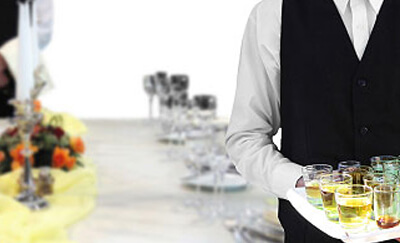
Limit the drink options, an open bar at a wedding can quickly become an expensive surprise.
Think about drinks. Stick to white or red wines, champagne, beer or even a theme cocktail for your reception, but don’t offer it all. An open bar can eat up a lot of your budget and enthusiastic guests can sometimes order drinks that go untouched.
Do you know other ways to save money while still providing a feast?
Try before you buy.
Choosing a caterer can be daunting. Sticking to a restaurant you know and love or getting recommendations from friends are two of the best ways to find a caterer you can be comfortable with. No matter who you choose, make sure you arrange a tasting well in advance of the event. Try several options for each course and don’t be shy about requesting substitutions for sauces and side dishes.

Make sure the food looks good as well as tastes good - presentation is very important.
Also, make sure the food looks good as well as tastes good. Is it presented in an appealing manner? Are there special garnishes or plates? Is it served at the appropriate temperature? Try to ensure that the conditions of the tasting mimic the conditions of your reception as closely as possible.
Eat, drink and be merry.
Finally, relax and enjoy yourself and try not to sweat every detail. These are your good friends and family and you are enjoying a celebratory meal together as you embark on your new life. Chances are, no one will notice if the curly parsley didn’t make it on to every plate of roast beef!
Did You Know?
At ancient Irish weddings, the groom and bride protected themselves from evil by consuming salt and oatmeal before the wedding feast began. During the feast, the new couple were presented with, and drank from, a large goblet with two handles called a "quaich", as a symbol of the joining of their families. The quaich was most likely filled with a honey wine called "Bunratty Meade".
Although “Celtic” is typically a description that applies to Irish culture, it does extend to Scotland as well. Traditional Celtic cuisine is composed of both Scottish and Irish dishes including sheep, cow, fish, pork and lamb. Potatoes are the cornerstone of this cuisine and make a statement when served in traditional ways such as colcannon (potatoes and cabbage) and boxty (potato pancakes).



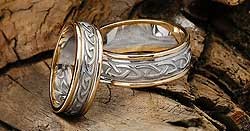
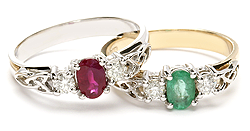
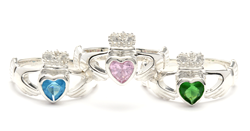
 Sapphire Engagement Ring
Sapphire Engagement Ring 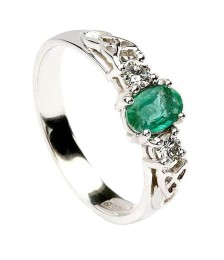 Emerald Engagement Ring
Emerald Engagement Ring 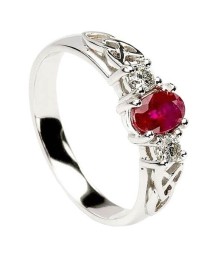 Ruby and Diamond Ring
Ruby and Diamond Ring 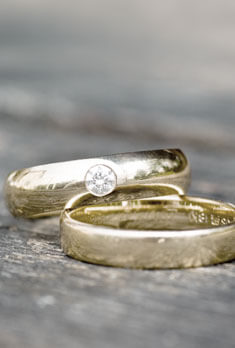

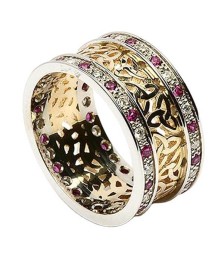 Trinity Cluster Ring with Ruby
Trinity Cluster Ring with Ruby 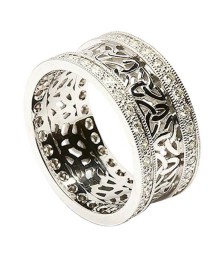 Trinity Cluster Ring with Diamond
Trinity Cluster Ring with Diamond 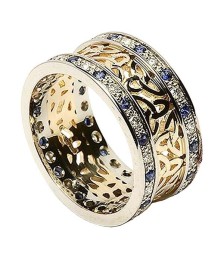 Trinity Cluster Ring with Sapphire
Trinity Cluster Ring with Sapphire 